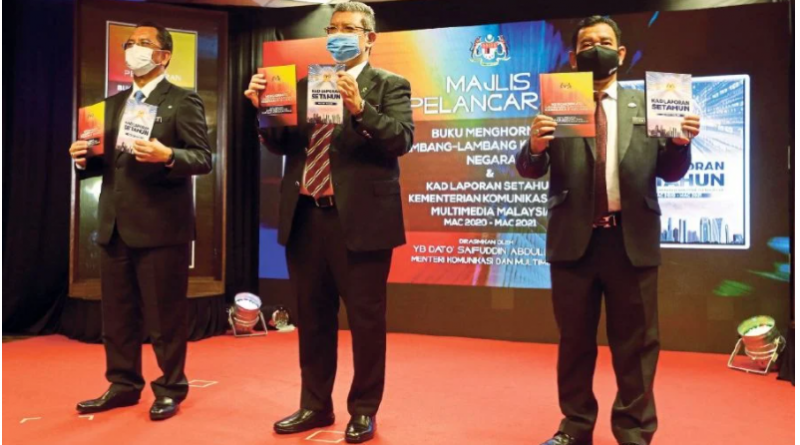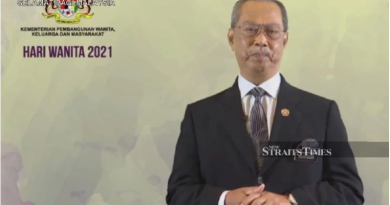Better connectivity for all
PUTRAJAYA: In anticipation of rapid digital transformation within a short span of time, the government has moved to strengthen telecommunications infrastructure and connectivity nationwide.
As a result, within three months since the implementation of the National Digital Network Plan (Jendela) , 443, 161 premises were equipped with fixed-line broadband via fibre-optic connectivity, 126 per cent of the initial target of 352,101.
Communications and Multimedia Minister Datuk Saifuddin Abdullah said 16,366 transmitting stations were also upgraded within the period to expand 4G coverage and increase the speed of mobile broadband in urban and suburban areas.
“This was 101 per cent of the initial target of 16,214,” he said when announcing the ministry’s one-year report card recently.
In line with better connectivity, Saifuddin said the Program Realisasi Impian Ekonomi Digital (Prime) was launched on Nov 27, to assist small-and medium-enterprises (SMEs) to increase their competitiveness in an increasingly challenging marketplace through digital economy-based programmes while raising public awareness of the importance of mastering digital skills.
“We had implemented the Program Perkhidmatan e-Dagang Setempat (PeDAS) at 37 Rural Internet Centres across the country.
“A total of 3,439 participants were trained and successfully marketed their products in the marketplace with RM2.5 million total revenue generated.”
As for the eRezeki programme, Saifuddin said 49,552 individuals were trained, a total of 359,281 digital workers were paid and they earned an additional income of RM560.75 million.
Some 10,001 participants were trained under the Global Online Workforce (GLOW) Programme last year, with 1,577 digital workers paid and total additional income stood at RM1.7 million.
In assisting the creative industry, the government had rolled-out the Malaysian Creative Industry Stimulus Package (Prisma), with an allocation of RM89.2 million to implement 32 programmes under four main components namely heritage, arts, media, and creative content.
“Of the total, RM67.7 million was in the form of grants, while RM9 million was for loans and RM12.5 million for broadcast slots.
“As of March 15, 21 programmes were opened with total applications standing at 7,870. A total of 2,458 applications were approved, with an amount of RM2.8 million.”
While the country was busy addressing the Covid-19 pandemic, Saifuddin said close cooperation in digital aspiration with neighbouring countries in Asean also remained as one of the ministry’s priorities.
The Asean Digital Masterplan 2025 (ADM 2025) was introduced during the first Asean Digital Ministers’ Meeting (ADGMIN1) held in Kuala Lumpur on Jan 21 and 22, with the theme ‘Asean — A Digitally Connected Community ‘.
The masterplan outlined eight Outcome Goals to make Asean a leading bloc of the digital community and its economy driven by secure and transformative digital services, technologies, and ecosystems.
The Putrajaya Declaration outlined the outcome of the discussions during the ADGMIN1 meeting and the commitment of Asean countries this year to strengthen cooperation towards information and communications technology development through the implementation of ADM2025.
Saifuddin said last year also saw the ministry, through RTM, becoming the official broadcaster of the Anugerah Nasyid Malaysia 2020 (ANAM 2020), which it organised together with Munsyid Malaysia.
Sharing his focus for this year, Saifuddin said for a start, the ministry has expedited the implementation of 5G, as it will drive the development of the country’s digital economy towards MyDigital aspiration by 2030.
The deployment of 5G will be spearheaded by a special purpose vehicle (SPV) owned by the government, under the purview of the Malaysian Communications and Multimedia Commission (MCMC).
“The provision and management of 5G infrastructure by SPV involves an investment of RM15 billion over 10 years, and enables the fair distribution of 5G capacity to telecommunication companies.”
Saifuddin said in line with these efforts, the government is also committed to establishing a National Digital Experience Centre to increase public awareness on the use of 5G as well as assist in the transition and its innovation.
The ministry is also developing a music corporation, to ensure the growth of the industry and the welfare of its players are being protected.
He said the ministry hoped to intensify digital economy investment facilitation, by increasing foreign direct investment and domestic direct investment, along with employment.
“The MyDigital initiative has the potential to attract an estimated investment of RM70 billion with the creation of 10,000 new jobs.”
Saifuddin said the ministry also seeks to empower digital forensic services in dealing with advanced cyber threats and tackling cybercrime, along with introducing the National Digital Identity Policy to provide a comprehensive framework for reliable, secure, and transparent digital transactions and data movement.
This year, the ministry is also looking at organising the International Nasyid Festival and ANAM 2021 towards making Malaysia the ‘Home of Contemporary Nasyid’ on the world stage.
“We are also developing a Road To Oscars and Grammy Awards Blueprint, which is a comprehensive action plan for the production of Malaysian creative products to win certain categories at prestigious international film festivals.”
Source: NST


